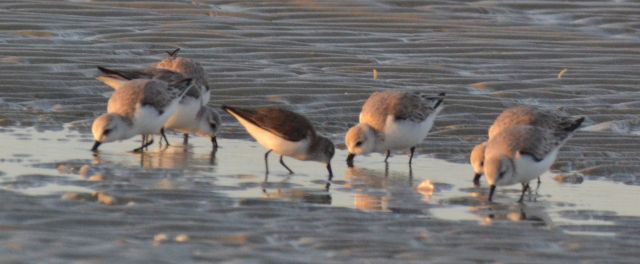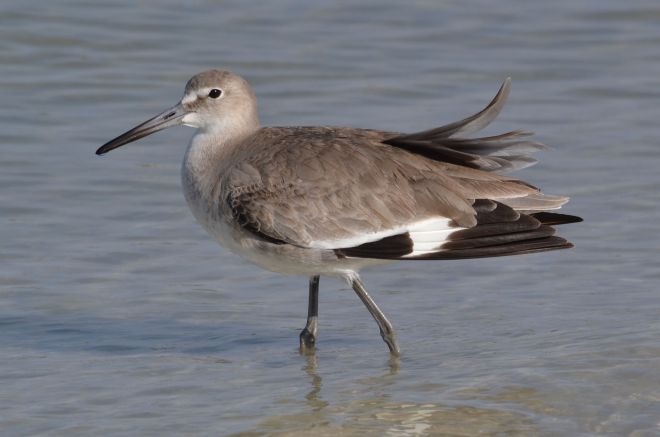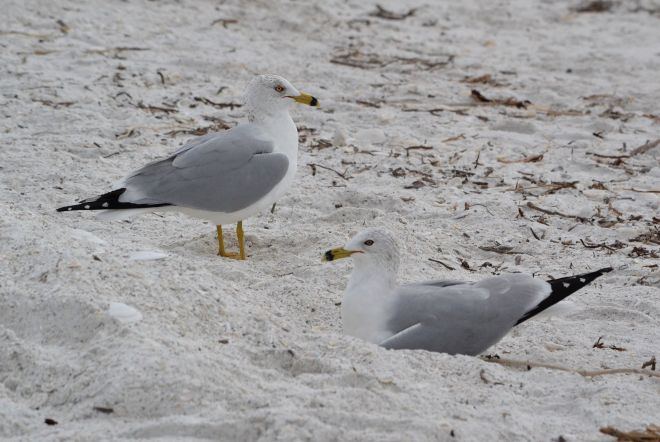On my first day in Fort Myers I visited Sanibel Island that lay conveniently close to my hotel. This is clearly a popular weekend playground, chock full of people and cars, so much so that traffic marshals were out directing things at busy road junctions and shopping centres. But there is a relative oasis amidst all the human activity that offered up another feast of Florida wading birds and now I effectively completed my set.
On the north shore of the island lies the J D Darling National Wildlife Refuge (see here), that is administered by the US Fish & Wildlife Service. This is a large wetland site with a five-mile, one-way wildlife drive ($5 /day) offering views over several inshore lagoons. I was moving in convoy with many other vehicles the whole time, which was a novel mode of birding. At intervals whenever a birdy area came into view vehicles would all pull over and disgorge their occupants to jostle and chatter some more. It had to be tolerated.
The first wading bird I noticed was at last a confirmed Reddish Egret (above) for the trip, that once seen as I had expected was quite different from anything else recorded previously. This instantly became my favourite Florida heron, having a kind of dancing jizz as it ran through the water and often going into the posture of shading the water with its wings held aloft.
This was quickly followed by close encounters with each of the Little Blue and Tricolored Heron (pictured above) that I had been confusing Reddish Egret with up until now. A few Yellow-crowned Night Heron (below) soon followed, being new here and so the only herons I missed on the trip were the two Bitterns, American and Least. YCNH was a welcome life list addition since it is found only in the Americas, while I have previously recorded Black-crowned at home and in various countries of southern Europe.
I had had to be patient to gain publishable pictures of the exotically plumaged Roseate Spoonbill on this trip, and now at this site there were two good opportunities. Having suffered drastic declines due to plumes hunting in times past, this unmistakeable wading bird now breeds in several large Florida Bay colonies. The light pink wings and backs of immature birds deepen gradually over three years, then the much richer-toned adults display an orange tail, bright red rump, shoulders and chest patch, and black skin on the neck. These winter plumage birds (below) were active in rather contrasty light but were still a joy to behold.
Most of the ducks were Blue-winged Teal (below, left) with some Lesser Scaup, and there were several Pied-billed Grebe (right) sightings. The third of those is a widespread water bird in Florida and I found them at several sites. A large group of American White Pelican (bottom) stood out at one stopping place, all sleeping or preening and presenting an untidy jumble of limbs and bills in the same way that Flamingos do.
Just as I was starting to feel hungry shorebirds began to appear rather distantly. So after a sandwich break I went back and drove round again with those in mind. The commonest again was Willet, with Dowitchers mixed in that American birders confirmed were Short-billed. Other shorebirds seen were all the same species we get on our side of the pond.
Also at this location, the day’s second photogenic group of Roseate Spoonbill resembled a cast of backstage ballerinas getting ready in the dressing room (below). The pale pink and fluffy juvenile (bottom row) looked especially charming in its own particular tutu. Musing, I hoped the sleeping birds might wake up before the performance begins.
On the next two afternoons I visited the National Audubon Society’s Corkscrew Swamp Sanctuary (see here) about an hour’s drive to the south-east. This preserves the largest remaining Bald Cypress forest in North America, having been saved from the logging trade that removed most of this habitat from Florida in times past. A 2½ mile boardwalk snakes its way through various mostly swamp habitats in which small birds were generally difficult to identify, as in the Keys and Everglades.
Red-shouldered Hawk (below, centre) are resident and announced themselves raucously at intervals, as did equally loud though considerably smaller Carolina Wren. The chuckling calls of Red-bellied Woodpecker, (below, right) the eastern US’ most common of the genus, issued from all around as I progressed. On occasion the louder drumming of Pileated Woodpecker (below, left) would pre-announce the appearance of these large black and red peckers that go by the affectionate name of “Woodies” after the cartoon character.
A lot of small passerines would move through at intervals, though due to my unfamiliarity with species and calls these were always difficult to distinguish from one another. Some that I did recognise were more Yellow-rumped, Pine and Black and White Warblers; Gray Catbird, Blue-gray Gnatcatcher, and most notably Summer Tanager that as it’s name suggests is a scarce sighting for Florida in winter. Great Crested Flycatcher (below, centre), being a widespread and common woodland resident in Florida, was a bird I came across many times on this trip.
This was a gem of a place in terms of habitat but ultimately the experience involved too much neck craning and unknowledgeable company to ultimately be satisfying. A few different snakes were listed on the sightings boards but the only one I actually saw here was Banded Water Snake, (pictured below) an inhabitant of freshwater habitats that is endemic to the central and south-eastern US. Though non-venomous this reptile is said to have a prickly disposition, and releases a foul smelling musk when threatened, but I didn’t get that close to find out.
My final image from this fascinating though rather too busy site is of an Anhinga nest (above) upon which a scope was trained at one point along the boardwalk. January is very early in the season for breeding to be taking place and so this attraction was manned by volunteers and a popular draw with passers by. Enough said.
Now, having done justice to wading birds but been so often frustrated by passerines, I needed to pay some attention to shorebirds. First light on 22nd found me at Bunche Beach Preserve on the landward side of the Sanibel causeway, that is said to be one of the better shorebird sites on this coast. There is a beach car park ($2 /hour) so it is possible to walk straight onto the exposed flats. It seemed like the wild and unspoilt end of the local beach district with off white sand that is characteristic of the region and an abundant litter of sea shells.
Here I quickly identified Semipalmated Plover and Wilson’s Plover (both above), that are like Ringed Plover with yellow / orange and dull pinkish legs respectively, and the latter has a thick black bill. Both are lifers with the first being especially pleasing since I didn’t bother to go for one that turned up on the Sussex coast a few years back, a decision I would not make now. Semipalmated is the most numerous small Plover of eastern North America, being the counterpart of Palearctic Ringed Plover.

Western Sandpiper (central bird) amongst Sanderling (record shot)
A third lifer I had hoped to observe here and now found was Western Sandpiper (above), another important one since it is a fairly regularly occurring autumn vagrant in Britain that I had yet to record. These were often running around amongst Dunlin and Sanderling, emphasising just how small they are. All three of these life list additions are regular at the site.
Everywhere else I went further south in Fort Myers Beach it was developed holiday resorts, but I did see the trip’s only Bald Eagle flying over Hickory Island and got close to some more fearless Western Willet (below). It would hardly do to have come to the United States of America and not seen the former. The previously conspecific Eastern and Western Willet were split recently. The first of those is strictly coastal and winters in South America, being replaced in Florida by the inland breeding Western counterpart.

Windswept Western Willet
A day later I visited Tiger Tail Beach Preserve on a third local playground, Marco Island. This has the reputation for being one of the best sites for viewing shorebirds on the entire Gulf Coast. After a tedious and congested drive out my spirits initially sank upon pulling into the almost full parking lot ($8 / day) of another public park. But boundless goodies were in store here and this was possibly the best single day of the entire trip.
The site has a long lagoon lying between an inner beach and an outer sand spit that runs to the north. The quick way out to the birding area is by wading through a shallow part of the lagoon, but I wasn’t dressed for that and so walked the long way around. On the inner beach I quickly began to see the three new shorebirds from a day earlier and also a first Least Sandpiper (above, left) for this trip, the last-named being a bird I have recorded twice previously at home.
These birds all seemed unphased by my presence, letting me walk amongst them with the camera, but this is a very popular beach area so they must be used to people. When I eventually reached the birding area on the far side of the lagoon things just got better and better and I ended up staying for about five hours. Semipalmated Plover and Short-billed Dowitcher were present in large numbers, putting into perspective the stir that occurs when just one of either turns up at home with rarity status.
Now there were two must-see shorebirds for this part of the world still to locate. Piping and Snowy Plover are both uncommon and localised in the region, though the latter is a resident along the Florida Gulf Coast. The world populations of these two lifers are just 10 and 25k respectively. They are typically encountered on open, sandy beaches such as this. Eventually there one of them was feeding busily along the lagoon edge, a dainty and diminutive Piping Plover (below, right) looking splendid in the midday sunshine.
On the return walk I came across a close group of eight Short-billed Dowitcher (below), the latter being a bird I had recorded just once previously in Great Britain. It was that good. This experience became a roll call of Nearctic shorebirds twitched at home in recent years, plus a few new species as well, which was exactly what I had hoped for during this trip. All the shorebirds in this post are pictured in adult winter plumage.
When I got back round to the inner beach, mid afternoon more Western Sandpiper (below, right) had joined the small shorebirds observed upon setting out earlier. It was good to get so close to Least Sandpiper (left), marginally the world’s smallest shorebird, here. Finally the easily distinguished Wilson’s Plover (centre) stood out as before by their impressive bills.
This whole exercise was very educational in terms of familiarising myself with numbers of Nearctic shorebirds in their own region. At home I would mostly have relied on other birders to point out the single vagrants being twitched, that is not so satisfying. What of other birds on Marco Island? All the while Brown Pelican fished the lagoon, Royal Tern were moving up and down offshore and Ring-billed Gull (below) loitered on the beach, but unfortunately no Magnificent Frigatebirds were passing by.

“Gosport? Are you kidding me buddy?” … “Say fella, ain’t that some kinda English hell town?”
The site is also a hotspot for Reddish Egret and on the walk back I enjoyed a picture session with one that let me walk right up to it. This remains my favourite Florida wading bird. I just love their fluffiness, rakish demeanour and dancing jizz. And thus the post ends as it began with a second collage of this wonderful bird.
My spirit was lifted and my heart gladdened in this superb place. I say that because it was just so good to be approaching birds on foot that could be properly observed and photographed, without having to crane my neck, think about passing traffic or being jostled on boardwalks. Outside of the national parks it seems there is little walkable countryside in which to lose myself in Florida; more a flat, uninteresting landscape upon which trespass is not tolerated. Hence birding means being channelled into public facilities, typically with over-peopled boardwalks and trails. At least on this day Tiger Tail beach was one location where the right sort of balance could be achieved.




















































